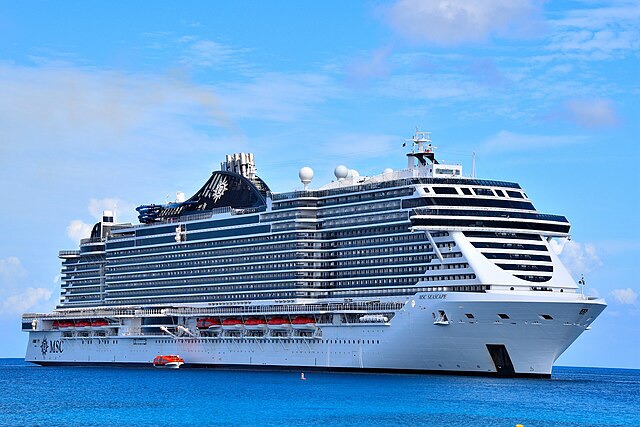
Cruise ships visiting Britain are frequently failing to utilise “zero-emission” onshore power, opting instead to run their engines and release pollutants into the local environment.
The cruise industry is facing increased scrutiny regarding air pollution and its contribution to greenhouse gases, prompting some European cities to ban vessels from central ports.
Although cruise operators claim that emissions can be reduced by switching off engines and connecting to low-carbon electricity when moored, an investigation by openDemocracy reveals that cruise ships at Southampton, the largest cruise port in Britain, often neglect onshore power usage.
Between April 2022 and July 2023, analysis of ship schedules at Southampton found approximately 300 days when at least one cruise ship was docked, but the onshore power facility was utilised only 71 times during the same period.
While some ships may not have been adapted for cleaner onshore power, cost remains a significant factor, as onshore power is more expensive than marine fuel. Cruise companies have the option to retrofit their ships with new technology for cleaner power usage, but not all choose to do so.
The UK Chamber of Shipping acknowledges cost as a factor but emphasises the potential for retrofitting ships with cleaner technology.
Jon Hood, the UK sustainable shipping manager at Transport & Environment (T&E), advocates for greater transparency. “There’s clean power available but the cruise companies don’t want to pay for it.”
Hood suggests that cruise operators should be compelled to disclose when they use onshore power and for how long. Additionally, he proposes that the government should mandate cruise ships to plug into onshore power when available.
Katherine Barbour, Southampton’s first Green party councillor, said: “If cruise liners aren’t mandated to change, this will continue and our residents will suffer. We need all berths to be able to provide onshore power, and ships need to be adapted to use it.
“Every ship is like a small town, spewing out pollution when they are not using electricity.”
Concerns about the environmental impact of the cruise industry persist despite being one of the fastest-growing tourism sectors. A study published in the Marine Pollution Bulletin in December 2021 revealed that a large cruise ship could have a carbon footprint greater than 12,000 cars. T&E’s analysis in June indicated that, despite the introduction of a new cap on sulphur in marine fuels in 2020, 218 cruise ships operating in Europe in 2022 emitted more sulphur oxides than a billion cars.
Several cities, including Venice and Amsterdam, have already banned cruise ships from their historic centres, citing environmental reasons. The industry has responded with commitments to greener practices, aiming for net-zero carbon cruising by 2050.
Carnival Corporation, the world’s largest leisure travel company, is investing in LNG-powered ships, and trials with biofuels are underway. However, critics argue that LNG engines and the fuel production process may leak methane, a potent greenhouse gas.
Associated British Ports (ABP), operator of the Southampton cruise port, launched an onshore power facility in April 2022, costing £9 million with support from the Solent local enterprise partnership. However, only one ship can connect to the facility at a time.
The Cruise Lines International Association reports that 46% of its member fleet can connect to shoreside electricity, with 32 ports offering shoreside power. A spokesperson said: “Connecting to shoreside electricity is a long-term element in the cruise industry’s decarbonisation strategy.”
ABP said: “ABP Southampton is proud to be a UK leader in the provision of shore power. It’s a service to our shipping customers that we want to grow. We see shore power as an integral part of the transition to net zero for both ABP and our customers.
“The port of Southampton has a UK-leading air-quality improvement and emissions reduction strategy, backed by a network of air quality monitors around the port. Real world air-quality monitoring research by Southampton city council demonstrates that air quality levels for port-related emissions are a fraction of other sources such as traffic.”
Port officials attribute the variability in onshore power usage to multiple factors, including high UK power costs. ABP plans to publish a 2023 shore-power performance review, shedding light on the progress and challenges in achieving emissions reduction goals.
Carnival Corporation said: “We use shore power in ports wherever available and operationally possible. However, despite the benefits, just 2% of the world’s ports have at least one cruise berth equipped with onshore power.”
——————————————————————————
At Natural World Fund, we are passionate about stopping the decline in our wildlife.
The decline in our wildlife is shocking and frightening. Without much more support, many of the animals we know and love will continue in their decline towards extinction.
When you help to restore a patch of degraded land through rewilding to forests, meadows, or wetlands, you have a massive impact on the biodiversity at a local level. You give animals a home and food that they otherwise would not have had, and it has a positive snowball effect on the food chain.
We are convinced that this is much better for the UK than growing lots of fast-growing coniferous trees, solely to remove carbon, that don’t actually help our animals to thrive.
This is why we stand for restoring nature in the UK through responsible rewilding. For us, it is the right thing to do. Let’s do what’s right for nature!
Donate today at https://naturalworldfund.com/ and join in the solution!
Image: Rene Cortin, CC BY-SA 4.0 , via Wikimedia Commons

